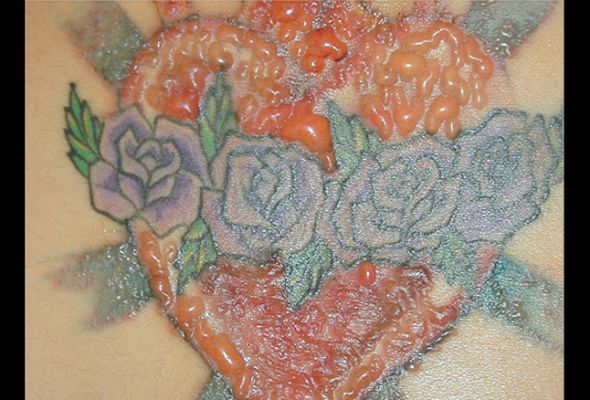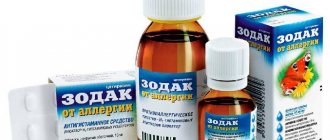Paint composition and possible allergens
Paint is considered the main cause of allergies. Modern salons do not use dyes containing mercury and metals. It is these components that significantly increase the risk of developing a negative reaction. But there are also fake paints.
Also, allergies may be associated with the use of products that the master prepared himself. If he did not comply with the proportions when mixing paints, then the likelihood of hypersensitivity increases.
Most often, unpleasant symptoms appear after using red and yellow paint. This is due to the presence of cinnabar and cadmium in their composition.
Sensitization to red pigment occurs not only with permanent tattoos, but also after applying temporary images using henna. Pigment ink has the following composition:
- red consists of mercury sulfide, iron hydrate, sandalwood, caesalpinium;
- black from ink, iron oxide, logwood;
- brown from iron oxide and ocher;
- blue from cobalt aluminate;
- green from chromium oxide, lead chromate, phthalocyanine dyes;
- yellow from cadmium sulfide, turmeric, chromium oxide;
- purple from manganese pyrophosphate and aluminum salts;
- white made of titanium oxide and zinc.
Cadmium sulfide is used to create yellow paints. This substance causes allergic reactions under the influence of ultraviolet rays. In this case, the place where the drawing was applied turns red and swells. The same problems often arise with red drawings.
Why is this happening?
- Using cheap ink from unknown brands, usually from China. Their composition is sometimes a closely guarded secret; incomprehensible components of unknown origin are used in their production. They do not have any safety certificates; appropriate dermatological tests have not been carried out on them. They are often not disdained by craftsmen who work unofficially, chasing maximum profits. The reason is simple - such pigments are much cheaper than branded paints. You can protect yourself from encountering such a product by contacting trusted salons. For example, the Syndicate Tattoo studio will never allow ourselves to use something like this; we value our reputation and care about the health of each client.
- The presence of an allergen in the pigment. Yes, this can apply even to high-quality paints. The main components of the product are purified water, alcohol and glycerin, but to obtain the required shade, substances of plant origin, which are quite strong provoking factors, can be used. These same substances can also perform an auxiliary function, for example, soften the skin. For example, logwood is sometimes used in black pigments, sandalwood in red, and turmeric in yellow. This point should be kept in mind, especially for those salon clients who suffer from allergies to pollen or other plant irritants.
- The use of a specific pigment in the pattern. The most common allergy is to red pigment. Somewhat less often - yellow; other colors are much safer in this regard. The reason is similar to the previous factor; it lies in the peculiarities of the composition, the use of cadmium sulfide and cinnabar. Both components are among the potentially dangerous irritants that can cause skin itching and severe redness. If you have a predisposition to allergies, but you cannot imagine your life without tattoos, then we advise you to avoid using these shades in the ornament.
Among the reasons that provoke allergic reactions, one can highlight the use of anesthetic ointment, which contains novocaine or lidocaine. Both substances, even in small concentrations, can provoke local allergic reactions.
When to abstain
It is not always possible to decorate your body with drawings without fear.
Important things to consider:
- Age. It is not advisable to get a tattoo before adulthood, since in childhood and adolescence the skeletal system actively develops, so the design becomes deformed. The same thing happens after getting a tattoo in old age, as the skin gradually sags.
- Presence of skin diseases. For psoriasis, dermatitis, dermatosis and other pathologies, this is prohibited, as it can only worsen the course of the underlying disease.
- Health status. In the presence of inflammatory processes accompanied by fever, cough, and runny nose, tattoos are prohibited, since after the procedure the symptoms will intensify.
- Increased sensitivity. It is not advisable to get a tattoo on sensitive areas such as the lower back or ankles, as this will be accompanied by unbearable pain. People who decide to do this should first administer anesthesia.
- Allergic predisposition. It is important to study the composition of the paint and ensure that the tools for applying the pattern are opened before the procedure. This will help avoid infection.
It is advisable to consult a doctor before the procedure. This will help eliminate dangerous diseases
.
What symptoms indicate an allergic reaction?
It is not difficult to understand that the immune system of a tattoo parlor client has negatively perceived any substance from a dye or ointment for pain relief. Symptoms characteristic of a contact type of allergy usually appear quickly - immediately after the procedure or after a certain period of time (after several hours, days and even months).
Changes in well-being with the development of allergies can manifest themselves in a local form, that is, directly at the site of application of the drawing:
- the skin area swells noticeably, itching appears;
- the tissues become hyperemic, that is, turn red;
- skin rashes appear - small, frequently located pimples or papules filled with liquid.
The rashes itch severely and persistently, and the patient has to endure the itching. If the skin breaks, there is a high probability of infection entering and inflammation developing.
The human body can react to an allergen in other ways:
- The tissues of the mucous membranes of the mouth, nose, and pharynx swell, and the tongue increases in size.
- The person notes that it becomes difficult to breathe, begins to cough, and sneeze frequently.
- A lot of mucus forms in the nose.
- The eyes begin to water and become noticeably red.
The necessary action if any of the symptoms appears is to immediately contact a medical facility.
Since ancient times, people have been decorating their bodies with tattoos. Body drawings are applied for different purposes - to display the special status of its owner, relationship to one of the social, religious or political groups, or simply for beauty.
Tattoos are extremely popular in our time. After visiting a tattoo artist, a person may notice that they have an allergy to a tattoo . It is necessary to find out what provokes such a reaction in the body, why it is dangerous and how to prevent its occurrence.
Symptoms
If there is an allergic reaction, the first manifestations will appear gradually:
- First, a person notices that the tattoo itches a lot.
- Urticaria develops.
- The area on which the drawing is applied turns sharply red.
- A rash appears on the tattoo. It gradually opens up and forms a scab.
- In severe cases, the larynx swells, breathing becomes difficult, and the likelihood of cardiac arrest increases.

If the first manifestations of the problem appear, you need to visit a medical facility for examination and treatment.
The development of generalized reactions is associated with the use of painkillers. The severity of symptoms may increase under the influence of ultraviolet radiation.
How to fix allergies
The formation of allergies is an indicator of the incorrect flow of technology, so it is worth paying attention to this parameter. If such negative consequences are detected, reflected in the deterioration of the client’s health, it is advisable to immediately contact a cosmetologist.
If you consult with a specialist, you can choose an option that will help correct the side effect after tattooing. However, taking risky drastic decisions on your own is not recommended, as it can be dangerous and ineffective.
Allergies can usually be corrected in two ways:
- Taking medications that correct allergies. This factor is usually recommended by experts when creating such a parameter. However, it may be ineffective in causing complications due to an allergic reaction. This happens if you start a strong reaction after tattooing.
- Removing permanent makeup. If you cannot correct the negative aspect by taking prescribed medications, the only solution to the pressing problem is to remove the style. Since the dye is an allergen, its removal from the body helps eliminate the negative consequences of this.
Eliminating the effect allows you to minimize the consequences after tattooing, because the absence of pigment means there is no reason for the formation of a side effect.
There are two ways to remove a tattoo:
- Remover is a solution that lubricates the surface of facial tissue. It penetrates the layers of the epidermis, which contributes to the gradual destruction of pigment particles and their removal with lymphatic fluid from the body. Such a gentle influence does not pose a risk to the client’s health, so it can be performed safely.
- Laser. In this case, the impact is more aggressive and just as effective. In cosmetology, a master works with equipment that is aimed at the area where the coloring matter needs to be lightened. Laser tattoo removal requires up to four visits to the establishment.
Removing permanent makeup helps eliminate allergies after the method. However, it does not always make sense to resort to such a drastic decision, since because of it, the service rendered becomes in vain for the girl.
Therapy depends on the specific allergen and the severity of symptoms. In mild cases, the doctor prescribes topical antihistamines, which must be applied to the inflamed area of the skin. Most often, dermatologists recommend wiping the tattoo area with salicylic alcohol, and then applying a thin layer of Hyoxysone or Boro-plus ointment.
Sensitivity to henna tattoos
Temporary designs made using henna are very popular. Various coloring additives are added to it to obtain the desired shade, since, for example, black henna does not exist.
To change the color, coffee, various herbs, as well as paraphenylenediamine and urzol are added. It is these components that often provoke a negative reaction from the immune system.
This hypersensitivity is characterized by rapid development. Therefore, urgent medical attention is needed. Very often the rashes fester, itch and hurt unbearably. Subsequently, this leads to the appearance of scars and changes in skin color.
Treatment options
If the tattoo itches or other signs of hypersensitivity appear, you need to undergo examination and detect the allergen. After this, therapy is selected.
The only option to avoid a non-standard reaction of the immune system is to avoid contact with the irritant.
Most often, hypersensitivity is caused by a genetic predisposition, so if it appears once, it will remain for a long time. Therefore, to avoid life-threatening conditions, the influence of allergens on the body should be avoided. In this case, you need to refuse to apply a tattoo.
If signs of hypersensitivity appear:
- Take an antihistamine. There are three generations of drugs to relieve allergic reactions. First generation drugs like Suprastin and Tavegil have a number of adverse reactions. They lead to drowsiness and can affect attention. Therefore, they should not be used if you need to drive a car. The second generation of drugs is not recommended for people with a history of heart and vascular disease. The latest generation products are considered the safest. They have no side effects and are safer for health compared to other medications.
- Corticosteroids are used. These are topical medications that are applied to relieve swelling after tattooing and other symptoms of the disease. Most often, doctors prescribe products with antibacterial properties and hormonal composition. This allows not only to eliminate the manifestations, but also to avoid the penetration of the infectious process into damaged skin. There is a high risk of staphylococci and streptococci entering the wound. Oxycort is used to prevent these problems. This drug in the form of an ointment is applied to flaky areas, and in the form of an aerosol is used for weeping rashes and swelling. Pimafucort and Fucidin cream may also be prescribed.
Tattoo allergies should only be treated under the supervision of an allergist. You cannot prescribe medications yourself, as they have a number of contraindications and adverse reactions.
First aid
If manifestations of allergies are noted after the session, then it is necessary to take antihistamines. It is best to use third-generation tablets that do not have side effects such as stress on the cardiovascular system and drowsiness. As an additional remedy, the use of topical ointments is recommended. They soothe irritated, inflamed skin, relieve itching and other unpleasant sensations, and also prevent infection from entering the wound. The best ointments are those that have a combined effect, containing both hormonal components and antibiotics.
Prevention
Before you decide to get a tattoo, you need to consider if you are allergic to anything. If yes, then it is better to give preference to temporary drawings. But if you have a strong desire to have a permanent image on your body, in order to avoid serious consequences, you need to follow these tips:
- Carefully study what the ink is made of. It is useful not only to have a conversation about the sketch, but also to talk about the composition of the inks that will be used to create the tattoo.
- Check skin sensitivity. This is achieved by applying a small amount of ink to the wrist. After this, the skin is observed for several minutes. If there are no symptoms, other tests may be worth doing.
- Conduct a skin reaction test after ink injection. To do this, inject a little paint under the skin. It is better to do this in the area where the drawing will be. If there is no reaction, you can safely carry out the procedure.
- Avoid fluorescent paints. Tattoos that glow in the dark are considered especially mesmerizing, but such beauty can significantly harm your health. The ink used for such drawings has a high level of allergenicity.
It is important to remember that if your temperature rises after getting a tattoo, you should urgently seek the help of a doctor, as this may indicate the development of an inflammatory process.
It is important to remember that body painters are not doctors, so they cannot determine what is causing your symptoms. If negative manifestations appear, you should not contact him, but visit a qualified specialist who can help in this situation.
Tattoo ink tests
Karin Lehner from the University of Regensburg in Germany and her staff published their study in the journal Contact Dermatitus. The study was conducted using precise laboratory techniques that can detect even the smallest traces of chemical compounds in a variety of commercially available black pigment inks. The compounds are primarily composed of coal and soot and have names such as Black Magic Diabolo Genesis. The results of these tests were not encouraging. It was discovered that some dyes not only damaged skin cells, but also DNA cells, causing the risk of skin cancer.
However, many of these tests were carried out on Japanese paint brands that do not meet European standards. Dr Paul Broganelli , specialist in dermatology and venereology, University Hospital of Turin, noted that the tests were carried out only on black ink, which has the highest concentration of harmful substances. Using this black ink caused a reaction in only 7% of cases . While Dr. Paul Broganelli's words are reassuring, it's a good idea to know your ink type and how your body reacts in advance.











